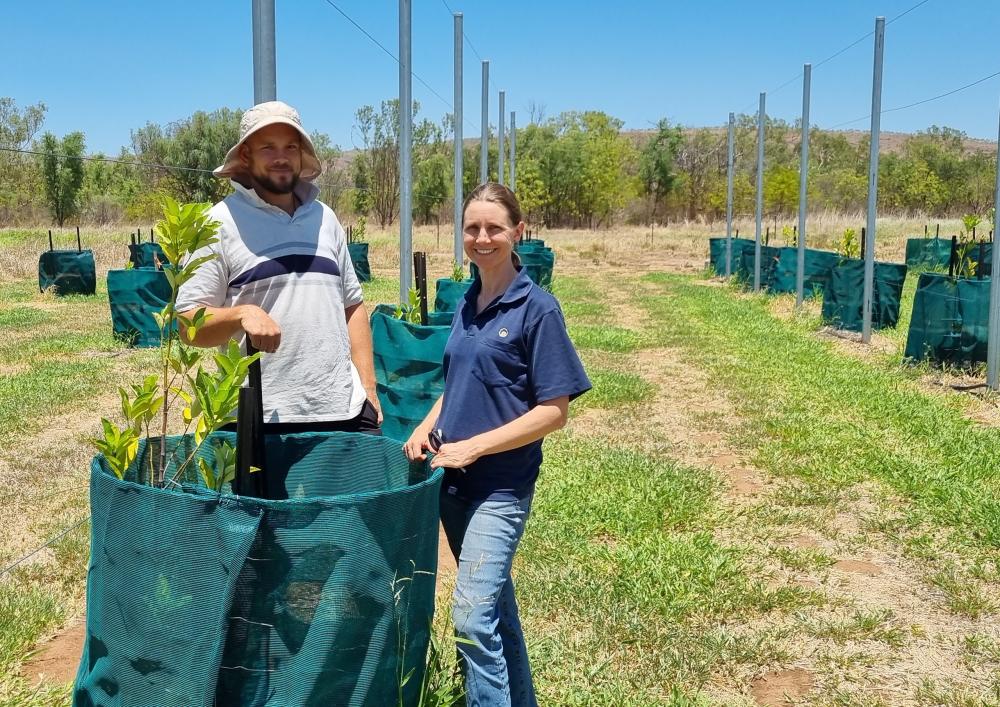
The potential to grow the popular Asian delicacy and meat substitute – jackfruit – in northern Australia was discussed at a field walk through a trial site at Kununurra.
The Department of Primary Industries and Regional Development (DPIRD) trial is part of a Cooperative Research Centre for Developing Northern Australia (CRCNA) project spanning Queensland, the Northern Territory and Western Australia.
The WA trial at DPIRD’s Frank Wise Institute is examining trellising alternatives to improve production capacity and profitability, as well as protect trees from the impact of cyclones and severe weather.
Jackfruit trees grow up to 20 metres tall and take at least five years to produce commercial quantities of fruit the size of footballs – typically weighing between five and 15 kilograms, sometimes more.
While fruit may be lost due to the impact of severe weather, trellising could prevent the greater cost of trees being uprooted in the event of a cyclone or storms that frequent the north.
About 80 jackfruit Galaxy variety seedlings, cultivated from seed collected from locally grown trees, were planted in the well drained, alluvial soil at the Kununurra site in February.
DPIRD research scientist Tara Slaven said the trial would compare performance of two trellising systems to free standing trees under local conditions.
“Fifteen trees are being grown to the palmette training system – angling the branches into the shape of a splayed hand – allowing for space between branches to improve spray penetration and make harvesting easier,” she said.
“Another 15 trees are being trained to the multi leader trellis – pruning the tree below the first wire to encourage multiple branches to climb up the trellis – increasing the number of limbs producing fruit, while protecting the trunk and fruit from sunburn.”
The three year trial has been planted at four metre row intervals to contribute to a better understanding of the merits of high density plantings in tropical environments, being led by the Queensland Department of Agriculture and Fisheries.
The 0.14 hectare site is irrigated by micro-sprinklers and soil moisture monitoring equipment has been installed to schedule irrigation.
Ms Slaven said the trial site had established well and the project had already produced some early findings.
“The sun at Kununurra is very intense and we have already discovered that jackfruit require shade during the establishment phase,” she said.
“Soil water monitoring also suggests the trees required more watering during the build-up, prompting an increase in irrigation frequency to three hours per cycle, three times a week.”
The researchers have also been examining the potential for propagation, with cuttings showing the most potential so far.
The trial results will be shared and compared with those in the NT and Queensland, where jackfruit orchards are more established.
A similar trial is also being established at DPIRD’s Carnarvon Research Station.
The Demonstrating Next-Generation Resilient Orchard Production Systems for Tropical Crops project is led by the Queensland Department of Agriculture and Fisheries and involves the NT Department of Industry, Tourism and Trade, Manbulloo Limited, Aus-Ex Fruit, the NT Farmers Association and Growcom.
CRCNA Chief Executive Officer Anne Stünzner said while the project focus was on jackfruit, the project outcomes could be translated to a broad range of potential tropical tree crops that could be grown in northern Australia.
“Jackfruit is a versatile tree crop that is highly suited for production in northern Australia and being used as a catalyst crop for this project,” she said.
“This next generation project will provide growers with production management advice, as well as strategies to mitigate the risks associated with tropical cyclones and severe weather in the north.
“The research will aid agricultural diversification in the north and the introduction of other crops, such as rambutan and cocoa.”
Picture caption: DPIRD technical officer Elijah Staugas and research scientist Tara Slaven monitor an 18-month-old jackfruit tree at the Frank Wise Institute, as part of a project examining the potential of the tropical crop in northern Australia.


